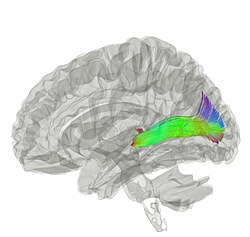

This article includes a list of references, related reading, or external links, but its sources remain unclear because it lacks inline citations. Please help improve this article by introducing more precise citations. (May 2015) (Learn how and when to remove this message)
|
| Optic radiation | |
|---|---|

Colour-coded diagram showing radiations in quadrants from retinal disc through the brain
| |

Tractography showing optic radiation
| |
| Details | |
| System | Visual system |
| Function | Vision |
| Identifiers | |
| Latin | radiatio optica |
| NeuroNames | 1440 |
| TA98 | A14.1.08.673 A14.1.09.542 A14.1.09.547 |
| TA2 | 5584 |
| FMA | 61941 |
| Anatomical terms of neuroanatomy | |
Inneuroanatomy, the optic radiation (also known as the geniculocalcarine tract, the geniculostriate pathway, and posterior thalamic radiation) are axons from the neurons in the lateral geniculate nucleus to the primary visual cortex. The optic radiation receives blood through deep branches of the middle cerebral artery and posterior cerebral artery.
They carry visual information through two divisions (called upper and lower division) to the visual cortex (also called striate cortex) along the calcarine fissure. There is one set of upper and lower divisions on each side of the brain. If a lesion only exists in one unilateral division of the optic radiation, the consequence is called quadrantanopia, which implies that only the respective superior or inferior quadrant of the visual field is affected. If both divisions on one side of the brain are affected, the result is a contralateral homonymous hemianopsia.
The upper division:
The lower division:
A distinctive feature of the optic radiations is that they split into two parts on each side:
| Source | Path | Information | Damage |
| Fibers from the inferior retina (also called "Meyer's loop" or "Archambault's loop") | must pass through the temporal lobe by looping around the inferior horn of the lateral ventricle. | Carry information from the Superior part of the visual field | A lesion in the temporal lobe that results in damage to Meyer's loop causes a characteristic loss of vision in a superior quadrant (quadrantanopia or "pie in the sky" defect.) |
| Fibers from the superior retina* | travel straight back through the parietal lobe to the occipital lobe in the retrolenticular limb of the internal capsule to the visual cortex. | Carry information from the Inferior part of the visual field | Taking the shorter path, these fibers are less susceptible to damage. Damage caused is characteristically called "Pie in the floor" defect or inferior quadrantanopia. |
*Note: In 2009, an anonymous medical doctor edited the "Optic Radiation" Wikipedia article and added the eponymous name "Baum's loop," referring to the dorsal bundle. Despite the information being unverified, this name subsequently entered scholarly articles and textbooks and persisted until three radiologists discovered the fabrication in 2020.[1]

The optic radiation contains tracts which transmit visual information from the retina of the eye to the visual cortex. Lesions of the optic radiations are usually unilateral and commonly vascular in origin. Field defects therefore develop abruptly, in contrast to the slow progression of defects associated with tumors.
Tracts contained within the optic radiation are examined as part of a cranial nerve examination.
|
| ||
|---|---|---|
| Illusions |
| |
| Popular culture |
| |
| Related |
| |
|
Anatomy of the diencephalon of the human brain
| |||||||||||||||
|---|---|---|---|---|---|---|---|---|---|---|---|---|---|---|---|
| Epithalamus |
| ||||||||||||||
| Thalamus |
| ||||||||||||||
| Hypothalamus |
| ||||||||||||||
| Subthalamus |
| ||||||||||||||
|
Rostral basal ganglia of the human brain and associated structures
| |||||||||
|---|---|---|---|---|---|---|---|---|---|
| Basal ganglia |
| ||||||||
| Rhinencephalon |
| ||||||||
| Other basal forebrain |
| ||||||||
| Archicortex: Hippocampal formation/ Hippocampus anatomy |
| ||||||||